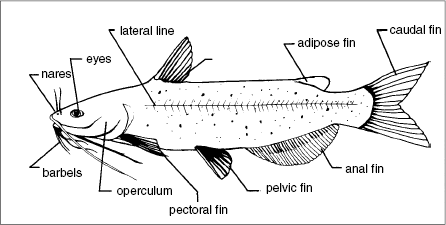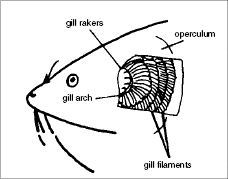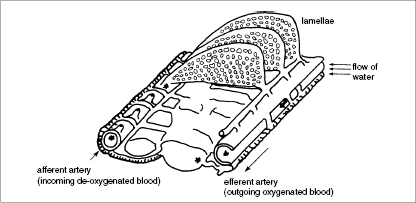
Members of the order Siluriformes are found in fresh and salt water worldwide. There are at least 39 species of catfish in North America, but only seven have been cultured or have potential for commercial production. They are the blue catfish, Ictalurus furcatus (LeSueur); the white catfish, Ictalurus catus (Linnaeus); the black bullhead, Ictalurus melas (Rafinesque); the brown bullhead, Ictalurus nebulosus (LeSueur); the yellow bullhead, Ictalurus natalis (LeSueur); and the flathead catfish, Pylodictis olivaris (Rafinesque).
Distribution
Channel catfish were originally found only in the Gulf States and the Mississippi Valley north to the prairie provinces of Canada and Mexico, but were not found in the Atlantic coastal plain or west of the Rocky Mountains. Since then channel catfish have been widely introduced throughout the United States and the world.
Physical characteristics
Like all native North American catfishes, a channel catfish
has a body that is cylindrical in cross-section, and lacks
scales. Fins are soft-rayed except for the dorsal and pectoral
fins which have sharp, hard spines that can inflict a nasty,
painful wound if a catfish is handled carelessly. An adipose fin
(lacking rays) is located on the back between
the dorsal and caudal fins (Figure
1). One conspicuous characteristic of all
catfish is the presence of barbels around
the mouth. The barbels are arranged in a
definite pattern with four under the jaw
and one on each tip of the maxilla (upper
jaw).
The channel catfish is the only spotted
North American catfish with a deeply
forked tail. There are 24-29 rays in the
anal fin. They are generally olivaceous to
blue on the back, shading to the off-white
ventrally.
Their color, to a large extent, is dictated
by the color of the water they inhabit.
In clear water they may appear
almost black, while in muddy water they
may be a light yellow. Young channel
catfish are irregularly spotted on their sides, but the spots tend
to disappear in the adults.

Figure 1: External parts of the Channel Catfish
Habitat
In natural waters, channel catfish live in moderate to
swiftly flowing streams, but they are also abundant in large
reservoirs, lakes, ponds, and some sluggish streams. They
are usually found where bottoms are sand, gravel, or rubble,
in preference to mud bottoms. They are seldom found in
dense aquatic weeds. Channel catfish are freshwater fish but
they can thrive in brackish water.
Channel catfish generally prefer clear water streams, but
are common and do well in muddy water. During the day they
are usually found in deep holes wherever the protection of
logs and rocks can be found. Most movement and feeding
activity occurs at night just after sunset and just before
sunrise. Young channel catfish frequently feed in shallow riffle
areas while the adults seem to feed in deeper water immediately
downstream from sand bars. Adults rarely move much
from one area to another and are rather sedentary, while
young fish tend to move about much more extensively,
particularly at night when feeding.
Feeding
Feeding can occur during day or night, and they will eat
a wide variety of both plant and animal material. Channel
catfish usually feed near the bottom in natural waters but will
take some food from the surface. Based on stomach analysis,
young catfish feed primarily on aquatic insects. The adults
have a much more varied diet which includes insects, snails,
crawfish, green algae, aquatic plants, seeds, and small fish.
When available, they will feed avidly on terrestrial insects, and
there are even records of birds being eaten. Fish become an
important part of the diet for channel catfish larger than 18
inches total length, and in natural waters fish may constitute
as much as 75 percent of their diet.
Channel catfish primarily detect food with their sense of
taste. Taste buds are found over the entire external surface of
catfish as well as inside the mouth, pharynx, and gill arches.
They are most numerous on the barbels and gill arches. In
clear water, eyesight can be an important means of finding
food. However, in turbid water, taste is the primary way catfish
locate food. The organ of smell (olfactory organs) may play
some role, but this has not been well established. The
olfactory organs are found in the nostrils (nares), which are
located on top of the head just in front of the eyes.
Age and growth
Channel catfish grow best in warm water with optimum
growth occurring at temperatures of about 85° F (29.4° C).
With each 18° F (10° C) change in temperature there is a
doubling or halving of their metabolic rate. This means that
within limits, their appetite increases with increasing water
temperatures or decreases with decreasing water temperatures.
In natural waters, the average size channel catfish caught
by fishermen is probably less than 2 to 3 pounds, but the world
record of 58 pounds was caught in Santee Cooper Reservoir,
South Carolina, in 1964. The size and age that channel catfish
reach in natural waters depends on many factors. Age and
growth studies have shown that in many natural waters
channel catfish do not reach 1 pound in size until they are 2
to 4 years old. One study in the Lake of the Ozarks, Missouri,
found that channel catfish did not reach a size of 13 inches
total length until they were 8 years old. The maximum age ever
recorded for channel catfish is 40 years, whereas most
commercially raised catfish are harvested before they are 2
years old.
In production ponds the growth rate of channel catfish is
determined by water temperature; length of time held at
different water temperatures; quantity and quality of food fed;
palatability, or taste of food; frequency of feeding; water
quality, etc. Most farm-raised catfish are harvested at a weight
of 11/4 pounds at an age of about 18 months.
Water Quality
Water quality preferences and limitations for wild channel catfish are not any different from those of farm-raised channel catfish. The lethal oxygen level for both wild and farm-raised catfish is about 1 ppm, and reduced growth occurs at oxygen concentrations of less than 4 ppm. Channel catfish, in natural waters, are no more tolerant of high levels of ammonia and nitrites than are farm-raised catfish, but are seldom exposed to lethal concentrations of either ammonia or nitrite.
Respiration

Figure 2: Schematic drawing of fish gills. |
Like other animals, channel catfish need oxygen to live. They use oxygen for energy production and to help build all the various parts of the body. However, oxygen is at most only about 25 percent as abundant in water as in the air. To get oxygen, fish must expend more energy than air-breathers. Fortunately, fish have well developed breathing organs, the gills. Although catfish live in the water, gills serve essentially the same functions as our lungs to take oxygen from the external environment and to rid the body of toxic gaseous waste, carbon dioxide (CO2). Water passes over the gill surface where oxygen diffuses into the blood and carbon dioxide diffuses out.
The gills of channel catfish are located on each side of the head (Figure 2) and they are covered by a protective movable flap of skin called the gill flap or operculum. There are four gills on both sides of the head, each consisting of a double row of slender gill filaments.
These filaments are supported by a flexible white gill arch. Each side of the filament has many thin, small cross plates called lamellae. It is across the gill lamellae that the important respiratory gases are exchanged (Figure 3). Each gill and gill filament has a rich supply of blood vessels which carries blood from the heart to the gills and then throughout the fish. The lamellae have spaces through which blood rapidly percolates. Oxygen that is picked up at the gill lamellar surface is carried throughout the body in the blood. Waste carbon dioxide is also carried in the blood for release into the water at the lamellar surface.

Figure 3: Schematic drawing of gill filament.
A fish breathes by sucking water in through the mouth
where it flows directly over the gill filaments and across the
lamellae. Blood channeled through the heart has a low oxygen
concentration, but at the gill lamellae surface it passes near
water high in oxygen. By simple diffusion, oxygen crosses the
gill surface and enters the blood where it is carried throughout
the fish. Respiration of this type is called counter-current
exchange. Simple diffusion of oxygen through the gill lamellae
and into the blood occurs because the gill lamellae are
extremely thin.
Carbon dioxide is released from fish in much the same
way oxygen is taken in by counter-current exchange. Blood
high in carbon dioxide is channeled through the heart to the
gills where it comes in close contact with water low in carbon
dioxide. By simple diffusion carbon dioxide is then released
into the water.
Depending on the needs of the fish, the rate of breathing
may be variable. Fish that are stressed or are pursued by a
predator have a greater oxygen demand than fish at rest.
Similarly, if the oxygen concentration in the water is low, a fish
has to breathe faster if it is to meet all of its oxygen requirements.
During normal respiration only about 60 percent of the
gill surface is used for gas exchange. During increased respiratory
demands, up to 100 percent of the gill surface may be
used.
It is easy to see that any alteration in gill structure or
function can be dangerous to catfish. Any increase in the
thickness of the gill lamellae will decrease the efficiency of gas
diffusion. If the gills become swollen or puffy, oxygen and
carbon dioxide transfer are decreased. Gills can become
thickened following exposure to ammonia, certain vitamin
deficiencies, or to long-term parasite or bacterial infestations.
Any type of toxic agent which damages the gill filaments or
lamellae will also affect the efficiency of gas exchange. Finally,
if a fish is anemic or has brown blood disease, even though the
gills are not damaged and there is adequate oxygen in the
water, the blood may not be able to carry enough oxygen to
ensure survival.
Spawning
Channel catfish spawn when the water temperature is
between 75° and 85° F (23° to 30° C) with about 80° F (27° C)
being optimum. Wild populations of catfish may spawn as
early as late February or as late as August depending on the
location. The length and dates of the spawning season vary
from year to year depending on the weather and area, but
peak spawning time in Mississippi usually occurs in May.
Channel catfish are cavity spawners and will spawn only
in secluded, semi-dark areas. In natural waters male catfish
will build a nest in holes in the banks, undercut banks, hollow
logs, logjams, or rocks. It is this behavior that necessitates the
use of spawning containers in order to successfully spawn
channel catfish in commercial ponds.
The male selects and prepares the nest by fanning out as
much mud and debris as possible. He will then defend this
location against any intruder until spawning is completed and
the fry leave the nest. The female is attracted to the nest and
spawning occurs within the nest with eggs being laid in a
gelatinous mass on the bottom. After the eggs are laid, the
male takes over and cares for the eggs by constantly fanning
them with his fins to provide aeration and to remove waste
products given off by the developing eggs.
Females spawn only once a year, producing about 3,000
to 4,000 eggs per pound of body weight, while the males may
spawn more than once. In wild populations, males seldom
spawn more than once a year, but in hatcheries where the
eggs are removed from the spawning container soon after
being laid, males may spawn 3 or 4 times; and there is a record
of one male spawning nine females in one season. Channel
catfish usually become sexually mature at 3 years of age,
although some may spawn when 2 years old. In wild populations
they may not spawn until after the age of 5 years.
Channel catfish weighing as little as 3/4 of a pound may spawn
if old enough, whereas farm-raised catfish usually weigh in
excess of 2 pounds when they spawn. After the eggs are laid
they will usually hatch in 5 to 10 days depending on water
temperature. At 78° F (26° C) the eggs will hatch in about 8
days. For each 2° F (1° C) rise in temperature above 78° F,
subtract 1 day, and for each 2° F (1° C) fall in temperature
below 78° F, add 1 day to get the approximate length of time
required for hatching. Water temperatures below 65° F (18° C)
and above 85° F (30° C) will reduce hatching success. Newly
hatched fry have a large yolk sac which contains the nourishment
they need for the next 2 to 5 days until they are fully
developed and are ready to start feeding. After the yolk sac
is absorbed, the fry take on their typical dark color and will
begin to swim-up looking for food. At first swim-up fry will gulp
air to fill their swim bladders which helps them maintain and
regulate their buoyancy.
Originally published on the Southern Regional Agricultural Center and the Texas Aquaculture Extension Service (February 2006)


